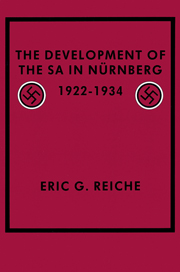Book contents
- Frontmatter
- Contents
- List of tables, figures, and maps
- Acknowledgments
- Introduction
- Abbreviations
- 1 Nürnberg and the emergence of National Socialism
- 2 Enter the stormtroopers: the Nürnberg SA, 1922–1923
- 3 “The guarantor of unity”: Nürnberg's SA between 1924 and 1929
- 4 Ready to assume power: the SA during the Great Depression
- 5 “The party bosses are our misfortune”: the Stegmann revolt, November 1932 to March 1933
- 6 The illusion of power: from the advent of the Third Reich to the Röhm putsch
- Conclusion
- Notes
- Bibliography
- Index
2 - Enter the stormtroopers: the Nürnberg SA, 1922–1923
Published online by Cambridge University Press: 21 October 2009
- Frontmatter
- Contents
- List of tables, figures, and maps
- Acknowledgments
- Introduction
- Abbreviations
- 1 Nürnberg and the emergence of National Socialism
- 2 Enter the stormtroopers: the Nürnberg SA, 1922–1923
- 3 “The guarantor of unity”: Nürnberg's SA between 1924 and 1929
- 4 Ready to assume power: the SA during the Great Depression
- 5 “The party bosses are our misfortune”: the Stegmann revolt, November 1932 to March 1933
- 6 The illusion of power: from the advent of the Third Reich to the Röhm putsch
- Conclusion
- Notes
- Bibliography
- Index
Summary
The internecine conflict between Hitler's organization and other völkisch groups, as well as Streicher's opposition to the NSDAP had prevented the establishment of a party local until October 1922. As a result, the formation of the SA in Nürnberg was similarly delayed. For its future development, this proved to be both an advantage and a drawback. When he swung his support behind Hitler, Streicher was already a well-known political figure in Nürnberg. Consequently, he could draw on a considerable following in building the Nazi movement in that city. Both party and SA would benefit from this. Aided by the economic and social turmoil of inflation and by Hitler's growing prominence in Bavaria, Nürnberg's NSDAP and SA grew rapidly during 1923.
Despite these successes, problems abounded. First, owing to its relatively late establishment, Nürnberg's SA had existed for little more than a year when Hitler's putsch resulted in the prohibition of the Nazi movement. Second, although Streicher was able to attract many followers with his abusive propaganda techniques, other Nürnberg citizens found these methods repulsive. This undoubtedly inhibited the growth of the SA. Third, Streicher's feud with the local SA leadership and with the local NSDAP organization during 1922-23 diverted energies and further limited the growth of the SA. Finally, the SA's establishment had been preceded by that of several other paramilitary organizations on the Right. Some of these were to provide the nucleus of the SA's membership; some would lose members to the SA during 1923, others, however, managed to compete successfully with the SA in the battle for the allegiance of rightist activists.
- Type
- Chapter
- Information
- The Development of the SA in Nurnberg, 1922–1934 , pp. 20 - 49Publisher: Cambridge University PressPrint publication year: 1986



